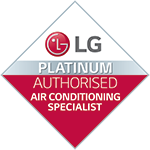All modern day split system air conditioning systems now have inverter type compressors. This is due to the minimum energy performance standards (MEPS) being pushed so far that non-inverter compressors won’t meet MEPS. This is not a bad thing, as inverter compressors are cheaper to run, quieter, draw less power on start-up, are smoother with less vibrations and have the ability to vary their capacity output to match the required heating and cooling load. The inverter compressor varies the capacity above/below the rated capacity, with the ability to go above the rated capacity. It’s like having 11 on the dial or an over boost function.
When we talk about split systems most people think of a wall mounted split system however split refers to the systems being split into two parts – the indoor unit and the outdoor unit. Whether it be a ducted, wall mounted, ceiling cassette, floor standing or a bulkhead, the indoor units have a few things in common. A fan to move the air around, a heat exchanger (where the heat is transfused from the refrigerant gas to the air) and a wired or wireless remote controller.
With old-fashioned non inverter single phase systems, it was near impossible to find a system over 6 kW Cooling, due to the high current draw and you would see the light dip when it turned on. Now they’re available as large as 10kw in wall mounted type and 16kw cooling in ducted type split systems.
Every home has single phase power and now with a higher capacity available on single phase systems, more houses are covered without the requirement and additional cost of upgrading to three phase power. It is necessary to upgrade to three phase power for systems over 16kw cooling.
Wall mounted type split systems are the cheapest to run, most efficient and the smaller the system, the better the efficiency they have. If we were to compare units on the extreme scale eg. 10 x Daikin split systems of 2.5kw cooling and a single ducted unit of 24kw cooling:
- 10 x Daikin FTXM25U = 25kw cooling, 32kw heating, with a rated power input of 4.9kw cooling and 6.4kw heating.
- 1 x Daikin FDYQ250LCV1 = 24kw cooling, 26.8kw heating, with a rated power input of 7.47kw cooling and 8.14kw heating.
Therefore the 10 x 2.5 kw units use about 35% less power for 4% extra cooling and in heating they will use about 22% less power for 19% extra heating. But do you want 10 outdoor units and 10 indoor units installed around the house?
This gap reduces as the wall mounted systems get larger. In saying that, a 20kw ducted air conditioning unit is still approximately 40% cheaper to run, than an equal capacity 5-Star 20kw ducted gas system.
Reverse cycle air conditioners are the cheapest way of heating your home. They are cheaper to run than gas heating whether its hydronic in-slab, radiator panel or ducted gas heating. It is also cheaper than electrical resistive heating, in-slab off peak, Nobo panel heaters, blow heaters, oil columns heaters, ceramic heaters or infrared radiator heaters. These systems are all about 3 to 5 times more expensive to run that reverse cycle air conditioning systems. The only heating that you’ll find cheaper (well actually it’s free) is the heat from the sun however that won’t keep you warm when it’s not shining.
As well as being cheaper to run, you are not burning fossil fuels to run the system (depending on where your power is sourced from) and if you have solar installed, you can get your heating and cool energy free from the sun when its shining. Using a split system for cooling removes the heat energy from the air, displacing it outside. Some will argue that evaporative cooling is cheaper, look at the section “Evaporative Cooling – Is It Any Good”?
Now you can decide whether a split system air conditioner will suit your home in Canberra.





